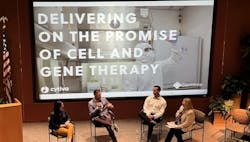Cleanroom technology leader Germfree Labs has taken the cell and gene therapy show on the road, leading a city-by-city educational series on solutions and considerations for the inherent challenges that come with CGT manufacturing.
The tour’s second stop was hosted by cell and gene therapy CDMO, Center for Breakthrough Medicines (CBM), in King of Prussia, Pennsylvania. The Promise of Cell and Gene Therapy event brought together thought leaders in cell and gene therapy innovation and offered tours of Germfree’s mobile cleanroom.
The panel discussions offered expert insights from CBM, Dark Horse Consulting, Cytiva and Germfree. Here are some key takeaways:
CGT trials are plagued by bottlenecks, and bottlenecks are expensive.
The current legacy model for clinical trials isn’t a perfect fit for cell and gene therapies. Autologous therapies — therapies manufactured from patients’ cells — require a supply chain with meticulous storage, labeling, traceability, packaging and shipping requirements. The logistical issues that come with this high-touch customer service model cost both time and money, which could ultimately result in delays and access issues for patients down the line.
The current focus, according to John Lee, head of Cell Therapy Manufacturing at CBM, is on transitioning from an autologous to an allogeneic space. Allogeneic therapies could create more affordable and more scalable ‘off-the-shelf’ gene therapy products. Lee predicted the industry could see a “rush of allogeneic therapies” in the clinic as soon as 2025-2026.
CGTs are racing towards the clinic at breakneck speeds.
Moving therapeutics safely and rapidly from concept to clinic is top of mind for the CGT industry. Lee noted the importance of de-risking and mitigating potential safety issues before getting to the IND stage. In the rush to keep up, said Lee, therapeutics are being pushed into the trials so quickly that R&D isn’t aligning with what’s happening in the clinic.
“Patients are being infused so fast that we don’t have the starting data to connect pre-clinical space with the clinic,” said Lee, of the industry in general. “We are building the plane as we are flying it.”
CBM has risen to the occasion by helping small biotechs, universities and large pharma companies to advance gene therapies from discovery to first-in-human studies in a manner that lessens both risk and expense.
Germfree’s new bioGO cGMP Mobile Cleanroom was open for tours
Flexible facilities are still in, but ballrooms are out.
Manufacturing facility design will need to evolve to accommodate the shifting needs of cell and gene therapies. According to Emily Moran, vice president of Vector Manufacturing at CBM, facilities will need to feature flexible multi-product designs. This will allow manufacturers to support different platforms such as plasmids, viral and non-viral vectors, and autologous and allogeneic cell therapies.
But unlike traditional mAb facilities, where large ballroom operation areas containing several fully closed processes are popular, gene therapy facilities require higher levels of containment and thus, segregated suites.
The patient-to-patient nature of autologous therapies means facilities have to be designed with clear organizational flows, in order to reduce the chance of batch mix-ups.
“When designing flexible facilities, you need to be thoughtful about the operations behind the science,” said Moran.
Moran also anticipates that rather than relying entirely on costly single-use systems, CGT facilities could utilize a more hybrid single-use/stainless steel approach.
Vendors are dialed in to the needs of the CGT industry.
Germfree’s new bioGO cGMP Mobile Cleanroom — which is headed to the West Coast on tour later this year — was designed to solve many of the growing pains and complex challenges that have been outlined by the cell and gene therapy industry.
The fast, flexible space allows clinical trials to start when needed, reducing early financial obstacles. The mobile platform can help address logistical challenges and bottlenecks, while de-risking and future-proofing for a rapidly evolving industry.






